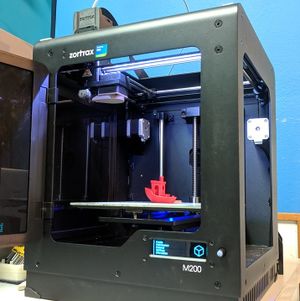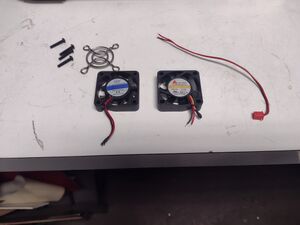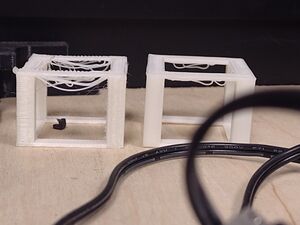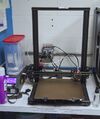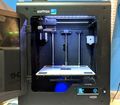Zortrax M200 3D Printer
The Zortax M200 is a 3D printer generously donated by Northrop Grumman Corporation.
User Guide: https://docs.google.com/document/d/1d5R4mEZI3laMhDZAmBS_YOvCCKxeParys71TMqCmo_Q/edit?usp=sharing
Critical Usage Information
This section contains instructions for successfully using the 3d printer. Failure to follow these instructions may result in failed prints or printer damage.
Automatic Leveling
Since the Zortrax automatically levels by forming a conductive path with the hotend, it is critical to perform the following steps while the hotend is heating:
- Clean the extruder nozzle and ensure that any charred plastic is removed from the nozzle surface
- Scrape the conductive pads on the printbed and ensure that there is no leftover plastic obstructing the conductive path between the pad and the nozzle
- Babysit the printer through automatic leveling and power off the printer if a nozzle collision occurs
Failure to perform the previous points can result in a printer damage, bad rafts, or failed prints.
Hotend Information
Qualification testing is not successful with PLA. This may be attributed to potential cooling issues with the hotend.
The hotend has a working fan (Fan2) that replaced the fan with a broken blade (Fan1). Fan2 is salvaged from the replaced IIIP sheet-metal filament cooler. Fan2 has been showing signs of bearing degradation and has therefore been slated for replacement in the near future. It has been noted that sleeve bearings such as the one found in Fan2 are subject to increased wear and significantly reduced service life at elevated temperatures, so a replacement with ball bearings is recommended.
The hotend is currently insulated since the bare hotend would take too long to heat up and is susceptible to significant thermal losses.
Historic Information
It was found that the hotend heatsink had a partially-threaded hole for the setscrew in 2021. This issue was fixed in mid 2022. This possibly augmented thermal performance, but the printer still does not pass PLA qualification tests.
The hotend had a partial-working fan replacement Fan2 since the original fan had a blade fall off.
Filament Information
ABS is currently the only filament qualified for use on the printer. The default extrusion profile from Zortrax may heat the ABS to a higher temperature than required, so new guidelines temperature control guidelines are being developed for the refinement of ABS use.
ASA is a strong candidate for use on the printer with the exception that the printing profile has not been tuned yet. It has been noticed that the extrusion temperature is too high for ASA at the moment and prints utilizing ASA show significant drooping on mildly-unsupported regions. Better printing temperatures are still being developed for the qualification of ASA use.
PLA fails printer qualification testing. The same issue is reported on internet forums, and extensive modifications exist to allow PLA printing. The current 3D printing situation at the lab has not required the use of PLA on this printer since there exist other printers at the space that can print with PLA at comparable quality to the Zortrax.
Enclosure
The Zortrax M200 is covered with black acrylic panels that were installed on the printer when it was obtained. This includes the front, hinged panel.
The front panel has had the magnet strips on it replaced with small neodymium magnets purchased from a local Daiso store. The adhesive on the original magnet strips failed.
Optional Top Enclosure
Since ABS suffers from severe thermal expansion and warping during printing, some operators have requested the use of a top enclosure to reduce the thermal shock on the work while it is being printed. This has resulted in the construction and use of multiple top enclosures including the current cardboard incarnation.
The body of the current cardboard enclosure is constructed from a salvaged cardboard box and hot-melt glued velcro. The cover of the current cardboard enclosure includes a peltier solid state cooling module and associated heatsinks which were salvaged from a cigar refrigerator which was found while dumpster diving. Future plans include turning the enclosure into a heated, temperature controlled chamber.
Other attempts at shielding the top of the Zortrax M200 have been discarded. These include a foamboard enclosure and a wooden enclosure in reverse chronological order.
Fume Filtering
Currently, fume filtering is not employed during use of the Zortrax M200 printer. It is recommended that operators do not reside in the same room as the printer while it is in operation due to health concerns involving microplastic inhalation. A foul odor is emitted from the printer during operation which is sufficient to cause operators to exit the room while the printer is in operation.
Historically, the Zortrax was attached to the Pruex filter with a foamboard upper enclosure. The purex's suction would continuously draw more heat from the extruder than the extruder could supply, causing the printer's extruder heating sequence to time out. The enclosure had to be set up so that the lid was ajar so that the printer could operate. Some members had difficulty leaving the lid ajar even when instructed to, so use of the Purex filter was abandoned.
Operators' Log
Brandon 2022-12-12
Y.S. Tech YW04010012BSS Ball bearing fans were purchased and a new fan was selected Fan3. The Zortrax M200 was placed under maintenance to finally replace Fan2. Fan replacement may be complicated by the state of the fan cable since previous fan replacement noted that the splice on the fan cable made it harder to thread through the cable harness in the printer's extruder assembly. It may be necessary to have two splices and three lengths of wire: a length to the red JST-XH 2-Pin connector, a length that would sit inside the extruder wiring path, and a length left wired into the fan.
Brandon 2022-12-13
The Y.S. Tech fan, Fan3, was not the right voltage (12 instead of 24 volts) and just stayed in a stalled state when power was applied. It can be theorized that an overvoltage lockout prevented the fan from spinning because the fan spun afterwards despite not spinning while powered by the 3d printer. Fan3 may be used on the Creality CR10S since the fan on the Creality is also suffering from bearing failure.
The wire on Fan3 was spliced according to the previous operator notes on 2022-12-12 and to a longer length of 25cm since the wire entry position on the fan is further away than it was on either Fan1 or Fan2. The length on the JST-XH crimp side is 4cm. The length in the printer conduit is 19cm. The length already attached to the fan is 1cm.
A newly developed technique for threading the fan cable through the printer conduit was developed in order to ease cable installation. The JST-XH connector is removed from the cable, and the raw crimped ends along with a length of cable including the heat-shrunken splice are covered with unshrunken 3/32" heat-shrink tubing and then guided through the printer conduit. This is an improvement on the "brute force" method previously utilized to replace the fan.
Brandon 2022-12-31
The new G4010H2B Fan4 is working well and moves more air than the original fan for the Zortrax printer.
The first and second sections of the wire from the operator log on 2022-12-13 was reused, and the operator notes that it is approximately 4cm too long. A length from the fan's original wire of 3cm was also left; this may be considered the third section of the wire to the fan. The extra length did ease installation and may be fine to the long term operation of the printer.
The newly developed technique from 2022-12-13 was not used since the wire needed to be spliced between the second and third sections.
Heat-shrink applied onto the wire was assisted by using the Y-axis carriage as a temporary holder for the fan while a lighter was used to shrink the heat-shrink-tubing.
It should be noted that Pin 1 on the red JST-XH connector for the fan is connected to +24v fan power, and Pin 2 is connected to ground.
Brandon 2023-01-10
From internet forum information, it was decided that the Zortrax extrusion temperatures may be very high in comparison to what is actually needed for 3d prints. This has been noted during raft printing of the prints and during the printing of bridges and overhangs.
The Zortrax M200 was tested with generic ABS for bridge / temperature tuning. The file selected for bridging testing is the "Calibration Box of Awesome" from Thingiverse. An acceptable bridge was observed with generic ABS at 240C instead of the default temperature settings.
The bridges tested were measured at 4mm at 250C and 2mm at 240C. Additionally, the sections of the bridge that seemed to be detached from the main 3d print body were much higher (near 100%) in the 250C print and around 1/2 in the 240C print.
Other 3D Printers
This page is a part of our ongoing effort to document our 3D printers.
